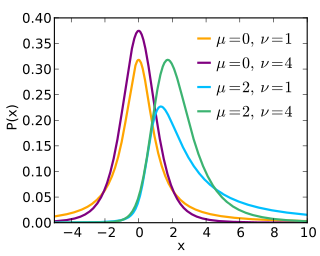
In mathematics, a holomorphic function is a complex-valued function of one or more complex variables that is, at every point of its domain, complex differentiable in a neighbourhood of the point. The existence of a complex derivative in a neighbourhood is a very strong condition, for it implies that any holomorphic function is actually infinitely differentiable and equal, locally, to its own Taylor series (analytic). Holomorphic functions are the central objects of study in complex analysis.

In mathematics, the Cauchy integral theorem in complex analysis, named after Augustin-Louis Cauchy, is an important statement about line integrals for holomorphic functions in the complex plane. Essentially, it says that if two different paths connect the same two points, and a function is holomorphic everywhere in between the two paths, then the two path integrals of the function will be the same.

In mathematics, the Laurent series of a complex function f(z) is a representation of that function as a power series which includes terms of negative degree. It may be used to express complex functions in cases where a Taylor series expansion cannot be applied. The Laurent series was named after and first published by Pierre Alphonse Laurent in 1843. Karl Weierstrass may have discovered it first in a paper written in 1841, but it was not published until after his death.
In mathematics, Green's theorem gives the relationship between a line integral around a simple closed curve C and a double integral over the plane region D bounded by C. It is named after George Green, though its first proof is due to Bernhard Riemann and is the two-dimensional special case of the more general Kelvin–Stokes theorem.

In probability theory and statistics, the Rayleigh distribution is a continuous probability distribution for nonnegative-valued random variables. It is essentially a chi distribution with two degrees of freedom.
In mathematics – specifically, in differential equations – the Picard–Lindelöf theorem, Picard's existence theorem, Cauchy–Lipschitz theorem, or existence and uniqueness theorem gives a set of conditions under which an initial value problem has a unique solution.
In mathematics, infinite-dimensional holomorphy is a branch of functional analysis. It is concerned with generalizations of the concept of holomorphic function to functions defined and taking values in complex Banach spaces, typically of infinite dimension. It is one aspect of nonlinear functional analysis.

In mathematics, the Stieltjes constants are the numbers that occur in the Laurent series expansion of the Riemann zeta function:
In Bayesian probability, the Jeffreys prior, named after Sir Harold Jeffreys, is a non-informative (objective) prior distribution for a parameter space; it is proportional to the square root of the determinant of the Fisher information matrix:
In mathematics, Carathéodory's theorem is a theorem in complex analysis, named after Constantin Carathéodory, which extends the Riemann mapping theorem. The theorem, first proved in 1913, states that the conformal mapping sending the unit disk to the region in the complex plane bounded by a Jordan curve extends continuously to a homeomorphism from the unit circle onto the Jordan curve. The result is one of Carathéodory's results on prime ends and the boundary behaviour of univalent holomorphic functions.
In geometric topology, Busemann functions are used to study the large-scale geometry of geodesics in Hadamard spaces and in particular Hadamard manifolds. They are named after Herbert Busemann, who introduced them; he gave an extensive treatment of the topic in his 1955 book "The geometry of geodesics".

As with other probability distributions with noncentrality parameters, the noncentral t-distribution generalizes a probability distribution – Student's t-distribution – using a noncentrality parameter. Whereas the central distribution describes how a test statistic t is distributed when the difference tested is null, the noncentral distribution describes how t is distributed when the null is false. This leads to its use in statistics, especially calculating statistical power. The noncentral t-distribution is also known as the singly noncentral t-distribution, and in addition to its primary use in statistical inference, is also used in robust modeling for data.

In complex analysis, a branch of mathematics, the antiderivative, or primitive, of a complex-valued function g is a function whose complex derivative is g. More precisely, given an open set in the complex plane and a function the antiderivative of is a function that satisfies .
In complex analysis, Fatou's theorem, named after Pierre Fatou, is a statement concerning holomorphic functions on the unit disk and their pointwise extension to the boundary of the disk.
In complex analysis, a field within mathematics, Bloch's theorem gives a lower bound on the size of a disc in which an inverse to a holomorphic function exists. It is named after André Bloch.
In mathematics, the Hermite constant, named after Charles Hermite, determines how short an element of a lattice in Euclidean space can be.
The Birnbaum–Saunders distribution, also known as the fatigue life distribution, is a probability distribution used extensively in reliability applications to model failure times. There are several alternative formulations of this distribution in the literature. It is named after Z. W. Birnbaum and S. C. Saunders.
In mathematics, the Earle–Hamilton fixed point theorem is a result in geometric function theory giving sufficient conditions for a holomorphic mapping of an open domain in a complex Banach space into itself to have a fixed point. The result was proved in 1968 by Clifford Earle and Richard S. Hamilton by showing that, with respect to the Carathéodory metric on the domain, the holomorphic mapping becomes a contraction mapping to which the Banach fixed-point theorem can be applied.
In mathematics, the connective constant is a numerical quantity associated with self-avoiding walks on a lattice. It is studied in connection with the notion of universality in two-dimensional statistical physics models. While the connective constant depends on the choice of lattice so itself is not universal, it is nonetheless an important quantity that appears in conjectures for universal laws. Furthermore, the mathematical techniques used to understand the connective constant, for example in the recent rigorous proof by Duminil-Copin and Smirnov that the connective constant of the hexagonal lattice has the precise value , may provide clues to a possible approach for attacking other important open problems in the study of self-avoiding walks, notably the conjecture that self-avoiding walks converge in the scaling limit to the Schramm–Loewner evolution.
Von Kármán swirling flow is a flow created by a uniformly rotating infinitely long plane disk, named after Theodore von Kármán who solved the problem in 1921. This problem is used as a model for centrifugal fans or compressors. This flow is classified under the category of steady flows in which vorticity generated at a solid surface is prevented from diffusing far away by an opposing convection, the other examples being the Blasius boundary layer with suction, stagnation point flow etc.












